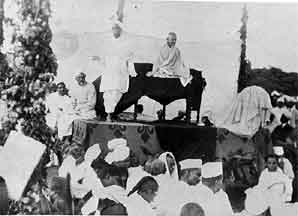1930 Gandhi Leads Revolt
Gandhi began his revolt against British rule by leading a march to the Gujart seacoast. There, he illegally made salt. The march was the beginning of both a widespread campaign of civil disobedience and some less peaceful rioting. In Peshawar, government troops fired on an unarmed crowd, killing thirty persons. In May, Gandhi was arrested and held without trial. By year's end, sixty-thousand had been arrested, one-hundred and three killed and more than four hundred injured by police...
.
IIn 1882, the British colonial government established a monopoly on the production and sale of salt in India, making it illegal for Indians to produce or sell their own salt. This salt tax disproportionately affected the poor, as salt was a dietary necessity and its price was artificially inflated by the tax.
In early 1930, Mahatma Gandhi and the Indian National Congress decided to challenge the British salt tax. On March 12, 1930, Gandhi and 78 followers set out on a 241-mile march from his Sabarmati Ashram to the coastal village of Dandi in Gujarat. Along the way, the number of marchers grew into the thousands.
On April 6, 1930, after 24 days of marching, Gandhi reached the Arabian Sea at Dandi. He picked up a small lump of natural salt and declared, "With this, I am shaking the foundations of the British Empire." This act of civil disobedience marked the beginning of a nationwide movement against the salt tax.
The Salt March inspired millions of Indians to participate in acts of civil disobedience, including making and selling salt illegally. This mass defiance against British rule led to the arrest of more than 60,000 people, including Gandhi himself.
The Salt March captured international attention and highlighted the the problems with British colonial rule in India. The the campaignsignificantly weakened British authority and brought the Indian independence movement to the forefront of global politics.
 >
>